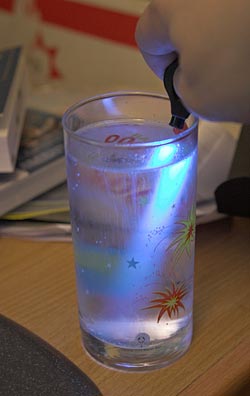I'm surprised how many people don't know...
...that tonic water glows under ultraviolet light.
(In this case, light from a UV Photon light.)
Modern tonic water (and bitter lemon, and a beverage made frae girders) only has a little bit of quinine in it. The original anti-malarial version of tonic water had far more of the stuff, which made it medicinally effective but also very bitter, such that adding a generous slug of gin to it could only make it taste better. Well, after you'd consumed enough doses, anyway.
Even a little quinine is more than enough for an impressive glow, though - quinine is often used in photochemistry as fluorescence standard, for this reason.
The ingredients label on the tonic I drink (usually straight; it's an acquired taste) lists quinine as "0.5%". If that's an accurate by-weight figure, then if you manage to put away a whole 1.25 litre bottle of the stuff, you've consumed something in the order of 6.25 grams of quinine. That's more than ten times the every-eight-hours medicinally effective dose of quinine dihydrochloride or sulfate (for IV or oral administration, respectively), which suggests to me that the listed concentration is a severe overstatement.
I did a nice before-and-after shot of a whole bottle of glowing tonic water for this old letters column. Wikipedia's version of the same thing is here.

11 July 2007 at 11:24 pm
A couple of years ago I was diagnosed with a bit of the gout in my left foot. My doctor suggested that I drink a glass of tonic water ever morning. The excruciating pain has not returned. But even after nearly 2 years of daily dosing I still can't stand the taste. Dan, you are made of sterner stuff than I.
12 July 2007 at 2:15 am
Hmm.. I've always quite liked the taste of tonic water. Then again, I eat lemons like most people eat oranges so my tastebuds may not make for a very good baseline.
I once suggested, in jest, to friend who had just built a nice water cooling rig with clear tygon tubing that he should fill it with tonic water and put a UV light in the case. He did so... the system failed rather messily a few hours later (bad seal, didn't seem to be caused by the tonic). The UV light showed quite nicely how the spray of water had covered 2/3 of the mobo and soaked the video card - made for a handy little troubleshooting tool (although the puddle in the case was a dead giveaway as to the problem).
12 July 2007 at 9:34 am
The makers of the film K19: The Widowmaker used the fluorescence of tonic water to simulate the look of Cherenkov radiation in the reactor room of the submarine. They initially tried some kind of powdered fluorescent dye which didn't work well, so they sent crew out to every grocery store in town and bought every case of tonic water they could get their hands on.
12 July 2007 at 7:41 pm
It is pleasing to note that adding the ice, gin (I like Bombay Sapphire) and slice of lemon has no noticeable effect on the light output.
As this remarkably poor quality shot that I took with my cellphone shows.
Light source was a fairly boring 12W linear cold cathode I found lying around the house. I think one of my flatmates bought it for a party.
12 July 2007 at 10:15 pm
when did you start letting people add reviews to your page, tho you did remind me about getting some sweet speakers. what type of amplipher would you use for those nice mk6 bookcase speakers?
13 July 2007 at 2:33 am
Mark Cocquio has been helping Dan out for quite a while now. Check the archives.